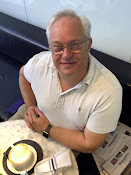My friend Peter Huck, journalist and windswept adventurer, recently moved away from Los Angeles with his other half, the lovely Barbara Drake, to beautiful New Zealand. They are living in a tiny apartment in Auckland with a very, very small kitchen. Since their excellent and mostly vegetarian dinner parties were such a feature of my social life here, and sadly missed, I asked Peter to think about writing a monthly letter from down under as a kind of mirror to my own efforts and experiences here. This is the fifth letter.
 The drought has broken. The weather map is dominated by "squally thunderstorms," near tropical downpours that drown speech, accompanied by violent wind gusts. In between cloudbursts the weather is surprisingly warm, good news for our nascent Coromandel rainforest: water plus warmth means excellent plant growth, especially as our ten-month old natives have spent the dry summer getting their roots down. It helped that the showers were preceded by "gardener's rain," steady, gentle precipitation that made the soil moist so that subsequent water didn't just run off.
The drought has broken. The weather map is dominated by "squally thunderstorms," near tropical downpours that drown speech, accompanied by violent wind gusts. In between cloudbursts the weather is surprisingly warm, good news for our nascent Coromandel rainforest: water plus warmth means excellent plant growth, especially as our ten-month old natives have spent the dry summer getting their roots down. It helped that the showers were preceded by "gardener's rain," steady, gentle precipitation that made the soil moist so that subsequent water didn't just run off.Streams have reappeared, tricking through nurseries of tiny, vividly green native plants nurtured amid dead tree fern fronds in the crepuscular light beneath the canopy. Three weeks from the shortest day, the epic skies above Two Caravan Hill are a racing pageant of blue skies and massive cloud formations as squalls sweep in from the Tasman Sea.
Periodically, they engulf the steep, forested slopes of Coromandel Range, which looms to our east. Right behind us is the Tokotea Kapanaga block, headwaters of Driving Creek, our water source all summer. Charles Ring found gold there in 1852 and now the government wants more, fingering the block as a possible bonanza and triggering growing opposition both in New Zealand and abroad. Last week over 33,000 public submissions were handed into Parliament. One, from London Zoo, expressed concern about Archey's frog. The Zoological Society of London describes this rare creature from the dinosaur era, as "the most evolutionary distinct and globally endangered amphibian on the planet.”
Whether Archey’s frog – plus Hochstetter’s frog and the brown kiwi, both found in the range - would survive renewed mining in Coromandel, still recovering from the 19th century onslaught, is moot. New Zealand’s government continues to play its cards close to its chest. Originally, 467,000 hectares [1.15 million acres] of Schedule 4 conservation land were tabled as potential mining prospects. This shrank to 7000 hectares, then 3,500. The public outcry suggests the government has miscalculated and may seek a compromise.
Curiously, the US mining giant Newmont, which runs the Martha open pit gold mine at Waihi, sent in a submission opposing further mining on Schedule 4 land in the Coromandel - at least for now. Newmont’s operations include Kalgoorlie’s “Super Pit,” a vast 3.6km long by 1.6km wide and 650m deep open-cut gold mine in Western Australia.
 The mining question is overlapping sniping about New Zealand's Emissions Trading Scheme, due to take effect in July. Critics blast the EMS, which is meant to reduce emissions 10-20% below 1990 levels by 2020, as either ineffective - agriculture, the country's biggest export earner and a major emitter of methane, a greenhouse gas, does not fully enter the scheme until 2015 - or a craven surrender to environmentalists. New Zealand projects a schizophrenic attitude towards climate change, prepared to enact the EMS even as it explores marine oil and gas deposits, the very fossil fuels that feed climate change.
The mining question is overlapping sniping about New Zealand's Emissions Trading Scheme, due to take effect in July. Critics blast the EMS, which is meant to reduce emissions 10-20% below 1990 levels by 2020, as either ineffective - agriculture, the country's biggest export earner and a major emitter of methane, a greenhouse gas, does not fully enter the scheme until 2015 - or a craven surrender to environmentalists. New Zealand projects a schizophrenic attitude towards climate change, prepared to enact the EMS even as it explores marine oil and gas deposits, the very fossil fuels that feed climate change.Maybe the Gulf of Mexico spill, and US moves towards a moratorium on more off-shore drilling, given its inability to halt the environmental catastrophe, will dampen such efforts, although New Zealand has awarded an exploration permit to the Brazilian oil giant Petrobras, infamous for a 2001 disaster when the world’s biggest floating oil platform sank in 1,300 metres off Brazil, killing nine. Any spill off the North Island’s East coast in the Raukumara Basin exploration area, which dives to 3,000 metres [BP’s well is at 1,500 metres], could prove far worse.



